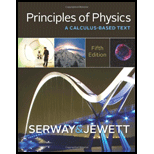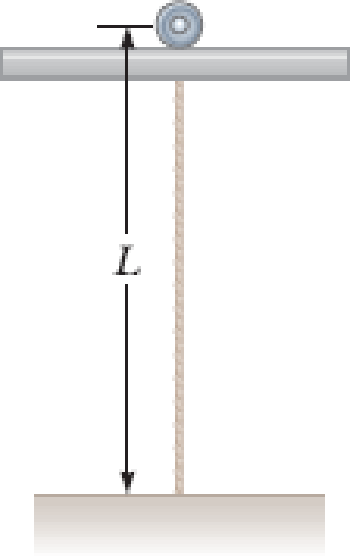
Concept explainers
A nylon string has mass 5.50 g and length L = 86.0 cm. The lower end is tied to the floor, and the upper end is tied to a small set of wheels through a slot in a track on which the wheels move (Fig. P14.56). The wheels have a mass that is negligible compared with that of the string, and they roll without friction on the track so that the upper end of the string is essentially free. At equilibrium, the string is vertical and motionless. When it is carrying a small-amplitude wave, you may assume the string is always under uniform tension 1.30 N. (a) Find the speed of transverse waves on the string. (b) The string’s vibration possibilities are a set of standing-wave states, each with a node at the fixed bottom end and an anti-node at the free top end. Find the node–antinode distances for each of the three simplest states. (c) Find the frequency of each of these states.
Figure P14.56

(a)
The speed with which the transverse waves travel
Answer to Problem 56P
The speed of the transverse waves is
Explanation of Solution
Write the equation for the speed of the transverse wave.
Here,
Write the equation for the mass per unit length of the string.
Here,
Conclusion:
Substitute
Therefore, the speed of the transverse waves is
(b)
The distance between the node and the antinode
Answer to Problem 56P
The node-antinode distance for the three simplest states is
Explanation of Solution
The distance between an adjacent node and antinode is on-quarter of a wavelength of the standing wave. There can only be odd number of node-antinode pairs as there is a node at the bottom and an antinode at the top.
Conclusion:
The simplest pattern is one node-antinode pair given as
Here,
The next simplest pattern is three node-antinode pairs given as
Therefore, there are three node-antinode pairs. Write the equation for the distance between the node and antinode in this pattern of three pairs.
Here,
Similarly, the next simplest pattern is
Here,
Therefore, from equation (II), equation (III) and equation (IV), the node-antinode distance for the three simplest states is
(c)
The frequency of the simplest states
Answer to Problem 56P
The frequency of the each of the simplest states is
Explanation of Solution
Write the equation for the frequency of the states.
Here,
Conclusion:
Substitute
Substitute equation (II) in equation (VI) and also
Substitute
Substitute equation (III) in equation (VIII) and also
Substitute
Substitute equation (IV) in equation (X) and also
Therefore, from equation (VII), equation (IX) and equation (XI), the frequency of the simplest states is
Want to see more full solutions like this?
Chapter 14 Solutions
Bundle: Principles of Physics: A Calculus-Based Text, 5th + WebAssign Printed Access Card for Serway/Jewett's Principles of Physics: A Calculus-Based Text, 5th Edition, Multi-Term
- Review. For the arrangement shown in Figure P14.60, the inclined plane and the small pulley are frictionless; the string supports the object of mass M at the bottom of the plane; and the string has mass m. The system is in equilibrium, and the vertical part of the string has a length h. We wish to study standing waves set up in the vertical section of the string. (a) What analysis model describes the object of mass M? (b) What analysis model describes the waves on the vertical part of the string? (c) Find the tension in the string. (d) Model the shape of the string as one leg and the hypotenuse of a right triangle. Find the whole length of the string. (e) Find the mass per unit length of the string. (f) Find the speed of waves on the string. (g) Find the lowest frequency for a standing wave on the vertical section of the string. (h) Evaluate this result for M = 1.50 kg, m = 0.750 g, h = 0.500 m, and θ = 30.0°. (i) Find the numerical value for the lowest frequency for a standing wave on the sloped section of the string. Figure P14.60arrow_forwardA block of mass M is connected to a spring of mass m and oscillates in simple harmonic motion on a frictionless, horizontal track (Fig. P12.69). The force constant of the spring is k, and the equilibrium length is . Assume all portions of the spring oscillate in phase and the velocity of a segment of the spring of length dx is proportional to the distance x from the fixed end; that is, vx = (x/) v. Also, notice that the mass of a segment of the spring is dm = (m/) dx. Find (a) the kinetic energy of the system when the block has a speed v and (b) the period of oscillation. Figure P12.69arrow_forwardAs shown in Figure P14.37, water is pumped into a tall, vertical cylinder at a volume flow rate R. The radius of the cylinder is r, and at the open top of the cylinder a tuning fork is vibrating with a frequency f. As the water rises, what time interval elapses between successive resonances? Figure P14.37 Problems 37 and 38.arrow_forward
- A string with a mass m = 8.00 g and a length L = 5.00 m has one end attached to a wall; the other end is draped over a small, fixed pulley a distance d = 4.00 m from the wall and attached to a hanging object with a mass M = 4.00 kg as in Figure P14.21. If the horizontal part of the string is plucked, what is the fundamental frequency of its vibration? Figure P14.21arrow_forwardReview. Consider the apparatus shown in Figure P14.68a, where the hanging object has mass M and the string is vibrating in its second harmonic. The vibrating blade at the left maintains a constant frequency. The wind begins to blow to the right, applying a constant horizontal force on the hanging object. What is the magnitude of the force the wind must apply to the hanging object so that the string vibrates in its first harmonic as shown in Figure 14.68b? Figure P14.68arrow_forwardReview. A sphere of mass M is supported by a string that passes over a pulley at the end of a horizontal rod of length L (Fig. P14.25). The string makes an angle θ with the rod. The fundamental frequency of standing waves in the portion of the string above the rod is f. Find the mass of the portion of the string above the rod. Figure P14.25 Problems 25 and 26.arrow_forward
- Two children stretch a jump rope between them and send wave pulses back and forth on it. The rope is 3.9 m long, its mass is 0.36 kg, and the force exerted on it by the children is 43 N. (a) What is the linear mass density of the rope (in kg/m)? ___________________ kg/m (b)What is the speed of the waves on the rope (in m/s)? ___________________m/sarrow_forwardTwo children stretch a jump rope between them and send wave pulses back and forth on it. The rope is 2.9 m long, its mass is 0.62 kg, and the force exerted on it by the children is 37 N. (a) What is the linear mass density of the rope (in kg/m)? kg/m (b) What is the speed of the waves on the rope (in m/s)? m/sarrow_forwardAn ethernet cable is 3.90 m long and has a mass of 0.210 kg. A transverse pulse is produced by plucking one end of the taut cable. The pulse makes four trips down and back along the cable in 0.810 s. What is the tension in the cable?Narrow_forward
- An ethernet cable is 4.15 m long and has a mass of 0.205 kg. A transverse pulse is produced by plucking one end of the taut cable. The pulse makes four trips down and back along the cable in 0.705 s. What is the tension in the cable? Answer in Narrow_forwardTransverse pulses travel with a speed of 200 m/s along a taut copper wire whose diameter is 1.50 mm. What is the tension in the wire? (The density of copper is 8.92 g/cm3.)arrow_forward
 Principles of Physics: A Calculus-Based TextPhysicsISBN:9781133104261Author:Raymond A. Serway, John W. JewettPublisher:Cengage Learning
Principles of Physics: A Calculus-Based TextPhysicsISBN:9781133104261Author:Raymond A. Serway, John W. JewettPublisher:Cengage Learning Physics for Scientists and Engineers: Foundations...PhysicsISBN:9781133939146Author:Katz, Debora M.Publisher:Cengage Learning
Physics for Scientists and Engineers: Foundations...PhysicsISBN:9781133939146Author:Katz, Debora M.Publisher:Cengage Learning

